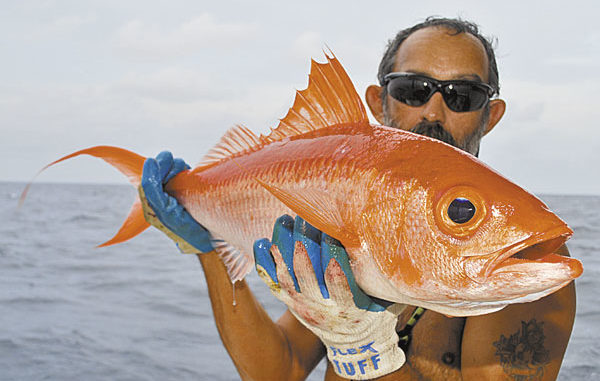
Yellow Cotton Bay still delivers the goods, but it’s just a shadow of its former self.
She’s beautiful; she’s exotic; she’s delicious.
Huh? Delicious?
You betcha. I’m talking about the queen snapper — one of my favorite fish in the Gulf of Mexico.
In a family of beautiful fishes, the queen snapper, Etilis oculatus, is undoubtedly the most beautiful and the most unusual. Her color can only be described as candy apple red, far redder then even the vermilion snapper and completely eclipsing the pinkish-orange of red snapper.
It possesses outlandishly large, almost luminescent eyes that are just as red as the rest of the fish, and its deeply forked tail often carries a long decorative streamer on the upper lobe. Even its body shape is odd, being very elongated and “un-snapperish,” even longer than the other long guy in the family, the yellowtail snapper. Its shape has given it one of the two nicknames that commercial snapper fishermen use for the species — the “ballbat.”
Thirteen species of snappers occur regularly, occasionally or rarely off the Louisiana coast. Nine of them — mutton, schoolmaster, blackfin, red, cubera, gray (mangrove), dog, lane and silk — are recognizable as snappers by their body shape and are grouped in the genus Lutjanus.
The family oddballs are yellowtail snapper (genus Ocyurus), the small but common wenchman (genus Pristipomoides), the vermilion snapper (genus Rhomboplites) and our protagonist here. The queen snapper is also the deepest-dwelling member of the snapper family throughout its range, which extends from North Carolina, around the Gulf of Mexico, through all the Caribbean Islands and down the coast of South America around the tip of Brazil.
Mostly unknown to recreational fishermen until recently, the species is quite familiar to commercial snapper fishermen, who also dub it a “silk snapper,” not to be confused with the true silk snapper, or a “silkie.” It is often found in association with other deepwater snapper/grouper species such as the vermilion snapper, the yellowedge grouper and the snowy grouper.
My first exposure to it came in the 1980s when I worked at LSU. We chartered long-line vessels to explore what were then considered underutilized deepwater species. When the first queen snapper landed on the deck, I couldn’t take my eyes off it. I was mesmerized.
The crewmen on the vessels were fascinated with the fish too — in the galley. Most of them pronounced it to be the best fish that they ever tasted. While good, to me they taste very similar to red snapper. They are extra mild and lean, almost to a fault, and are better fish for baking or poaching than for frying.
Wherever it is found, it is a deepwater species and associated with rock bottoms. That means it is most common near the edge of the continental shelf and down the continental slope, from 460 to 1,520 feet deep. In the Caribbean, it may be found as “shallow” as 313 feet, with one report of the fish being found in 195 feet of water.
In Louisiana, they seem to be most common in 500 to 700 feet of water and in association with rocky outcroppings and the smaller rock-covered salt domes that most anglers refer to as “lumps.” Unlike vermilion snapper, which may often be caught suspended over lumps, queen snapper are invariably bottom-dwelling fish.
Research on the species is scanty, and most of that comes from the Caribbean. There, like here, they will grow large, sometimes over 40 inches long, with weights of over 15 pounds. Virtually all the larger fish are females.
Research results from the Caribbean are likely to apply to the northern Gulf of Mexico as well. At the depths at which the species lives, water temperatures are a fairly constant 61 to 64 degrees throughout its range. In the Caribbean, males will begin maturing at 12 inches long and virtually all of them are mature by 18 inches. Females are slightly slower maturing, with the onset of maturity being 14 inches and 100 percent maturity at 22 inches.
Spawning seems to occur in the Caribbean in November and December, but this may vary from place to place. Reef fish located off of islands have been shown to spawn on different seasonal cycles than those located off of continents. Spawning does occur off of Louisiana, as commercial fishermen often find fish with ripe eggs and sperm, but a season has not been established.
Queen snapper are voracious predators and eat many species of smaller fish, as well as squid and octopus. Their mouth is full of small but well-developed teeth.
Louisiana recreational anglers are only now beginning to explore some of the natural habitats of deepwater fishes off of our coast. For years, our wonderful inland and nearshore fishing discouraged anglers from making the trek offshore. When they did go, it was and still is seductively easy to find fish by pulling up to an oil and gas platform.
Now adventurous fishermen are fishing “deep-drop” and finding an abundance of snowy grouper, yellowedge grouper and golden tilefish. It will only take a little time for these hardy souls to figure out where the queen lives.
Jerald Horst is the author of six books on fish and seafood, including the acclaimed Trout Masters: How Louisiana’s Best Anglers Catch the Lunkers. His latest book is Game Warden: On Patrol in Louisiana.


